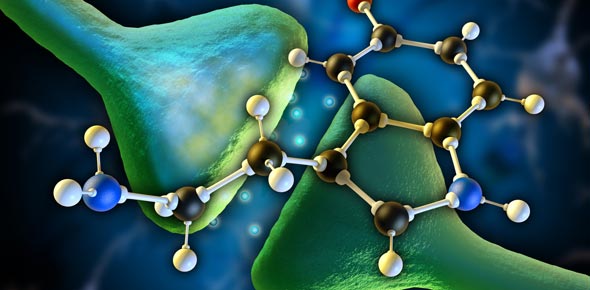Quiz7-2

- 1.
Hormones are
- A.
Carried in the bloodstream
- B.
Essential for the maintenance of homeostasis
- C.
Secreted by endocrine glands
- D.
All of the above
Correct Answer
D. All of the above -
- 2.
Once a hormone is released, an individual hormone usually acts
- A.
On all cells throughout your body
- B.
Only in association with chief cells
- C.
Only on target cells
- D.
Only on connective tissue
Correct Answer
C. Only on target cells -
- 3.
Which of the following is not true of protein hormones?
- A.
They are derived from chains of amino acids
- B.
They never enter the cell
- C.
They are lipid soluble
- D.
They activate a second messenger within the cell
Correct Answer
C. They are lipid soluble -
- 4.
Which of the following hormones is released from the posterior lobe of the pituitary gland in response to physical or prolonged stress?
- A.
Parathyroid hormone (PTH)
- B.
Adrenaline (epinephrine)
- C.
Antidiuretic hormone (ADH)
- D.
Adrenocorticotropic hormone (ACTH)
Correct Answer
C. Antidiuretic hormone (ADH) -
- 5.
Which hormone is in control of the internal biological clock (regulating such things as sleep, body temperature, and eating patterns)?
- A.
Parathyroid hormone (PTH)
- B.
Luteinizing hormone (LH)
- C.
Melatonin
- D.
Epinephrine
Correct Answer
C. Melatonin -
- 6.
Which of the following hormones is responsible of the development of the immune response?
- A.
Oxytocin
- B.
Parathyroid hormone (PTH)
- C.
Thymosin
- D.
Growth hormone (GH)
Correct Answer
C. Thymosin -
- 7.
If insulin is not produced or it cannot be bound to its target cells, the result is
- A.
Addison's disease
- B.
Hypoglycemia
- C.
Diabetes mellitus
- D.
Langerhanitis
Correct Answer
C. Diabetes mellitus -
- 8.
Which of the following is not part of the axial skeleton?
- A.
Skull
- B.
Sternum
- C.
Clavicle
- D.
Vertebral column
Correct Answer
C. Clavicle -
- 9.
Which of the following best describes the circumduction of a joint?
- A.
The movement of joint which reduces the angle between the bones on either side of the joint
- B.
A twisting or turning motion along the long axis of the distal bone
- C.
A motion which moves the distal bone away from the midline of the body
- D.
Moving a joint through flexion, abduction, extension, and adduction in succession so that the distal end of the limb describes a circle
Correct Answer
D. Moving a joint through flexion, abduction, extension, and adduction in succession so that the distal end of the limb describes a circle -
- 10.
Which of the following joints allows for 360 degree movement?
- A.
Suture
- B.
Cartilaginous
- C.
hinge
- D.
Ball and socket
Correct Answer
D. Ball and socket -
- 11.
Connective tissues is characterized by cells that
- A.
Produce glucose
- B.
Produce hormones
- C.
Are embedded in an extracellular, non-living matrix
- D.
Are capable of contraction
Correct Answer
C. Are embedded in an extracellular, non-living matrix -
- 12.
A strong, rigid connective tissue that makes up ligaments and tendons is called
- A.
Dense connective tissue
- B.
Loose connective tissue
- C.
Reticular connective tissue
- D.
Cartilaginous connective tissue
Correct Answer
A. Dense connective tissue -
- 13.
Which of the following connective tissues has a fluid matrix?
- A.
Nervous
- B.
Bone
- C.
Adipose
- D.
Blood
Correct Answer
D. Blood -
- 14.
What type of muscle is characterized by a rapid contraction and is active for short bursts of activity?
- A.
Slow twitch muscle
- B.
Fast twitch muscle
- C.
Smooth muscle
- D.
Cardiac muscle
Correct Answer
B. Fast twitch muscle -
- 15.
Which of the following describes the structure of the thin filament of a muscle fiber?
- A.
A bundle of myosin molecules
- B.
Two actin chains twisted together
- C.
A polymer of myosin and actin
- D.
A polymer of collagen fibers
Correct Answer
B. Two actin chains twisted together -
- 16.
Rigor mortis occurs after death because
- A.
No ATP is available to break the bonds between actin and myosin
- B.
Lactic acid builds up in the muscles
- C.
The muscle becomes infected with bacteria
- D.
Calcium is pumped back into the T-tube system
Correct Answer
A. No ATP is available to break the bonds between actin and myosin -
- 17.
The muscle which lines the digestive tract, pushing food along its length, is
- A.
Cardiac muscle
- B.
Skeletal muscle
- C.
Smooth muscle
- D.
Striated muscle
Correct Answer
C. Smooth muscle -
Quiz Review Timeline +
Our quizzes are rigorously reviewed, monitored and continuously updated by our expert board to maintain accuracy, relevance, and timeliness.
-
Current Version
-
Jan 17, 2013Quiz Edited by
ProProfs Editorial Team -
Aug 12, 2010Quiz Created by
Dlee7283
 Back to top
Back to top


